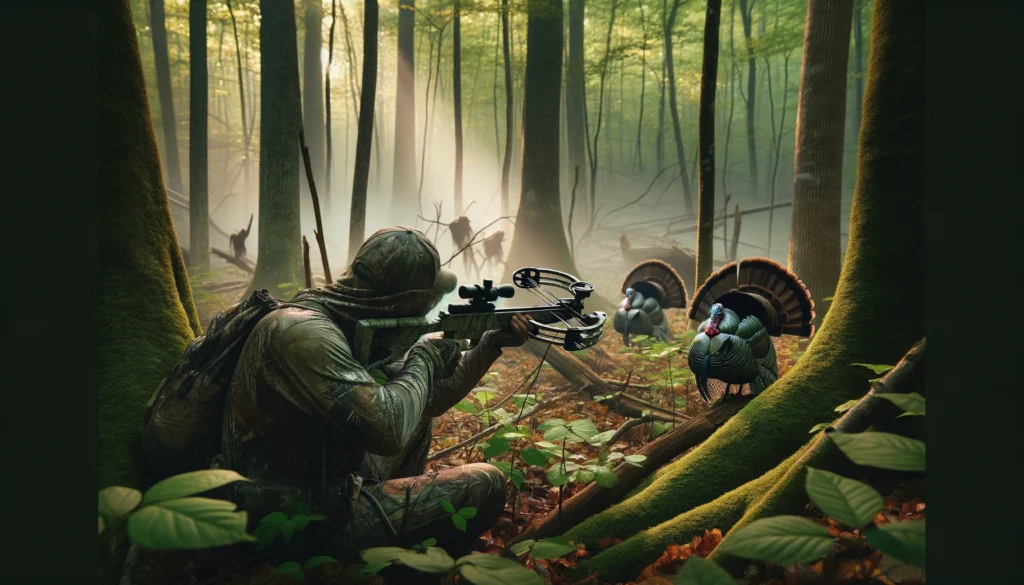Precision in the Wild: Crossbow Turkey Hunting Essentials

Table of Contents
- Introduction
- Understanding Turkey Behavior
- Crossbow Hunting Gear
- Tactics for Success
- Safety and Ethics
- Conclusion
- Frequently Asked Questions (FAQs)
- 1. Is a license required for crossbow turkey hunting?
- 2. Can I use a crossbow for turkey hunting in any state?
- 3. How close do I need to be to a turkey to ensure an effective shot with a crossbow?
- 4. What’s the best time of day for crossbow turkey hunting?
- 5. How do I practice for crossbow turkey hunting?
Introduction
Crossbow turkey hunting combines traditional hunting skills with modern technology, offering a unique challenge and rewarding experience in the pursuit of wild turkeys. This guide provides an overview of essential strategies, gear, and considerations for hunters looking to master the art of crossbow turkey hunting.
Understanding Turkey Behavior
Habitat and Patterns
Turkeys roost in trees at night and are most active during the early morning and late afternoon. They frequent areas where food is abundant, including fields, forests, and edges. Understanding these patterns is crucial for setting up a successful hunt.
Vocalizations
Turkeys communicate through a series of calls, including gobbles, clucks, and purrs. Familiarizing yourself with these sounds can help you locate turkeys and lure them into range.
Crossbow Hunting Gear
Selecting a Crossbow
Look for a crossbow with sufficient power to ensure a humane kill, typically with a draw weight of at least 150 pounds. Modern crossbows also offer features like scopes and noise-dampening technology to enhance accuracy and stealth.
Broadheads
Use broadheads designed for turkey hunting, which feature larger cutting diameters to maximize impact. Fixed or mechanical broadheads are both effective, but ensure they are sharp and well-maintained.
Camouflage and Concealment
Turkeys have keen eyesight, making effective camouflage essential. Match your camo pattern to your hunting environment and consider using a blind to conceal your movements.
Tactics for Success
Decoy Setup
Deploying decoys can enhance your chances of attracting a turkey within crossbow range. Use a combination of hen and jake (young male) decoys to trigger a dominant tom’s territorial instincts.
Calling
Use turkey calls sparingly and with variety to mimic natural turkey behavior. Overcalling can make turkeys wary, so observe their response and adjust accordingly.
Patience and Positioning
Turkeys can take time to approach, requiring patience. Position yourself with a clear view of the decoys and anticipated turkey path, ensuring you have a stable platform for your crossbow.
Safety and Ethics
Practice Ethical Hunting
Aim for a clean, ethical shot, targeting the vital areas of the turkey to ensure a quick and humane harvest. Know your crossbow’s effective range and limit shots to within this distance.
Safety Considerations
Always treat your crossbow with the same respect as a firearm. Keep the safety engaged until ready to shoot and be mindful of your target and beyond.
Conclusion
Crossbow turkey hunting offers an exciting blend of tradition and innovation, requiring skill, patience, and respect for the game and nature. By understanding turkey behavior, mastering your equipment, and employing strategic tactics, you can enjoy the thrill of the hunt while ensuring a respectful pursuit of these magnificent birds.
Frequently Asked Questions (FAQs)
1. Is a license required for crossbow turkey hunting?
Yes, most states require a hunting license and possibly additional permits for turkey hunting. Check local regulations for specific requirements.
2. Can I use a crossbow for turkey hunting in any state?
Crossbow regulations vary by state. Some states allow crossbows during specific seasons or for hunters with certain qualifications. Always verify the legal status in your area.
3. How close do I need to be to a turkey to ensure an effective shot with a crossbow?
While modern crossbows are capable of accurate shots at longer distances, limiting shots to within 30-40 yards can increase the likelihood of a precise, ethical kill.
4. What’s the best time of day for crossbow turkey hunting?
Early morning hours just after dawn and late afternoon before dusk are prime times for turkey activity, offering the best opportunities for hunting.
5. How do I practice for crossbow turkey hunting?
Practice shooting your crossbow at various distances to become comfortable with its operation and accuracy. Familiarize yourself with assembling and disassembling your equipment, especially if you plan to transport it to your hunting location.







